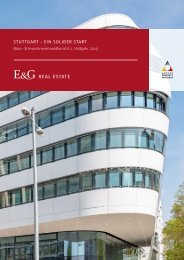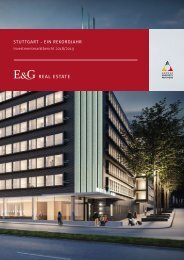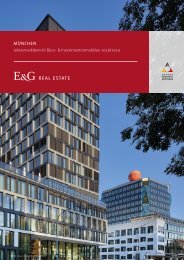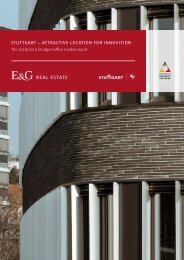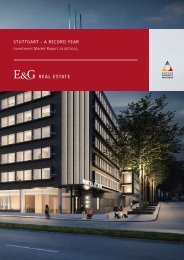E & G Industrial & Logistics Properties Stuttgart Region
You also want an ePaper? Increase the reach of your titles
YUMPU automatically turns print PDFs into web optimized ePapers that Google loves.
Foreword.<br />
With a share of 52.5% and ca. 117,000 square metres of space<br />
turnover, automotive OEMs and their regional supply chain continue<br />
to be the drivers of this positive trend. Their need for integrated<br />
processes has been feeding the space demand by automotive<br />
contract logistics and production-related forwarders.<br />
Markus Knab<br />
Head of <strong>Industrial</strong> & <strong>Logistics</strong> <strong>Properties</strong><br />
As a result, these market players have<br />
generated a market share of 20.5%<br />
in 2017, which corresponds to ca.<br />
49,000 square metres of logistics<br />
space.<br />
These figures make a strong case for<br />
a region, which is still highly dependent<br />
on the automotive sector. Yet,<br />
they are quite in line with nationwide<br />
trends and developments in Germany.<br />
According to an economic survey by<br />
the German ifo-institute from January<br />
2018, negative export expectations<br />
can be observed in nearly all<br />
industrial sectors. The exception to<br />
this rule remains the German car industry<br />
who are counting on a further<br />
upturn of their international business<br />
especially in Asia.<br />
The measures by the German government<br />
to promote e-mobility have also<br />
had a positive impact in the <strong>Stuttgart</strong><br />
<strong>Region</strong>. From our operative business<br />
and the current tenders in the automotive<br />
sector we can project an increased<br />
demand for electric drives<br />
and respective research and development.<br />
Yet, this structural change is not going<br />
to happen disruptively, but rather<br />
step-by-step. As the transition to<br />
e-mobility will still require the combustion<br />
engine as bridging technology,<br />
both drive systems will run parallel<br />
minimum up to 2025.<br />
The current trend for outsourcing<br />
in the automotive sector as well as<br />
in other industries will be pushed<br />
to a high level. This means that the<br />
automotive suppliers and logistics<br />
servicers of the <strong>Stuttgart</strong> <strong>Region</strong> can<br />
count on a stable and sustainable environment<br />
for their business. Especially<br />
system logistics providers profit<br />
from the commissioning of complex<br />
works such as pre-assembly to external<br />
partners. While such assignments<br />
place high requirements on the respective<br />
logistics facilities, they are<br />
rewarded with longer contract durations<br />
of five to seven, and in some cases<br />
of up to ten years.<br />
At the same time, the space demand<br />
from the industrial sector has been<br />
significantly lower with a share of<br />
merely 11.5% and an overall take-up<br />
of 27,000 square metres of industrial<br />
hall space. This can only partly<br />
be explained by the aforementioned<br />
trend for outsourcing to logistics<br />
service providers. Furthermore, the<br />
industrial companies of the <strong>Stuttgart</strong><br />
<strong>Region</strong> continue to strongly focus on<br />
their core business in order to meet<br />
the challenges of industry 4.0 (automation<br />
and digitalization).<br />
For the investment market in light<br />
industrial and especially for logistics<br />
property, the described trends seem<br />
to create a positive environment. However,<br />
the scarcity of the sought-after<br />
asset class logistics property has lead<br />
to a further compression of yields.<br />
Currently, the gross initial yield for<br />
such products still lies at 5%. Yet, it<br />
can be assumed that this figure will<br />
come under further pressure over the<br />
course of the year.<br />
The high space volume in the last<br />
year can be accounted for by the fact<br />
that many development projects were<br />
implemented on so-called brownfield<br />
sites (plots with previous industrial<br />
use). In some cases, the preparatory<br />
measures (remediation, species conservation,<br />
planning approval, etc.)<br />
had taken years in order to make<br />
these sites available for industrial<br />
re-development. On the basis of our<br />
on-going market research, we do not<br />
expect this trend for brownfield developments<br />
to continue on a comparable<br />
level in 2018.<br />
Likewise, the insufficient designation<br />
and therefore a limited availability<br />
of suitable greenfield plots will have<br />
a negative impact on the industrial<br />
and logistics space take-up in 2018.<br />
This becomes evident from the letting<br />
volumes in existing space, which<br />
have already plummeted by 30% in<br />
2017. In face of the overall scarcity<br />
of industrial and logistics space, the<br />
companies in the <strong>Stuttgart</strong> <strong>Region</strong><br />
are forced to either work with their<br />
existing space, or to look elsewhere<br />
for suitable facilities. Therefore, the<br />
tight market environment could be a<br />
further reason for the low space take-up<br />
of industrial companies in the<br />
previous year.<br />
At this point, local authorities are<br />
called upon to designate suitable sites<br />
for industrial and logistics use in<br />
the immediate vicinity of the region´s<br />
OEMs and their tier 1 suppliers. The<br />
prevailing negative preconceptions<br />
about logistics settlement must be<br />
challenged, because the logistics sector<br />
plays a key role for the competitiveness<br />
of the automotive industry in<br />
the entire <strong>Stuttgart</strong> <strong>Region</strong>.<br />
Next to the provision of a compatible<br />
road and IT infrastructure, also<br />
the availability of suitable industrial<br />
and logistics space will remain a core<br />
challenge for the economic success of<br />
the <strong>Stuttgart</strong> <strong>Region</strong>.<br />
Yours<br />
4 I<br />
I 5










